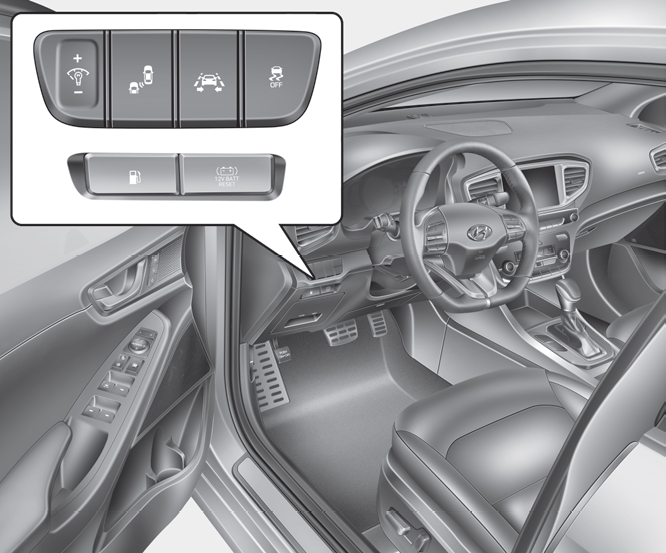Hyundai Ioniq: Braking System / Good Braking Practices
WARNING
Whenever leaving the vehicle or parking, always come to a complete stop and continue to depress the brake pedal. Move the shift lever into P (Park) position, then apply the parking brake, and place the Engine Start/Stop button in the OFF position.
Vehicles parked with the parking brake not applied or not fully engaged may roll inadvertently and may cause injury to the driver and others. ALWAYS apply the parking brake before exiting the vehicle.
Wet brakes can be dangerous! The brakes may get wet if the vehicle is driven through standing water or if it is washed. Your vehicle will not stop as quickly if the brakes are wet. Wet brakes may cause the vehicle to pull to one side.
To dry the brakes, apply the brakes lightly until the braking action returns to normal, taking care to keep the vehicle under control at all times. If the braking action does not return to normal, stop as soon as it is safe to do so and call an authorized HYUNDAI dealer for assistance.
DO NOT drive with your foot resting on the brake pedal. Even light, but constant pedal pressure can result in the brakes overheating, brake wear, and possibly even brake failure.
If a tire goes flat while you are driving, apply the brakes gently and keep the vehicle pointed straight ahead while you slow down. When you are moving slowly enough for it to be safe to do so, pull off the road and stop in a safe location.
Keep your foot firmly on the brake pedal when the vehicle is stopped to prevent the vehicle from rolling forward.
 Hill-Start Assist Control (HAC)
Hill-Start Assist Control (HAC)
The Hill-Start Assist Control (HAC) helps prevent the vehicle from rolling backwards
when starting a vehicle from a stop on a hill. The system operates the brakes automatically
for approximately 2 seconds and releases the brake after 2 seconds or when the accelerator
pedal is depressed...
 Blind-spot Collision Warning (BCW) system
Blind-spot Collision Warning (BCW) system
The Blind-spot Collision Warning (BCW) system uses radar sensors in the rear
bumper to monitor and warn the driver of an approaching vehicle in the driver's
blind spot area...
Categories
- Manuals Home
- 1st Generation Ioniq Owners Manual
- 1st Generation Ioniq Service Manual
- Temperature control
- Check Hybrid system, Check Hybrid system. Turn engine Off
- Check brakes/Check regenerative brakes, Check Virtual Engine Sound System
- New on site
- Most important about car
Hybrid Vehicle Interior Overview

1. Door lock/unlock button
2. Driver position memory system
3. Side view mirror control switch
4. Central door lock switch
